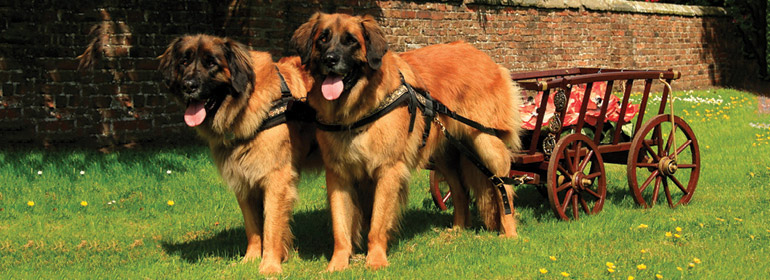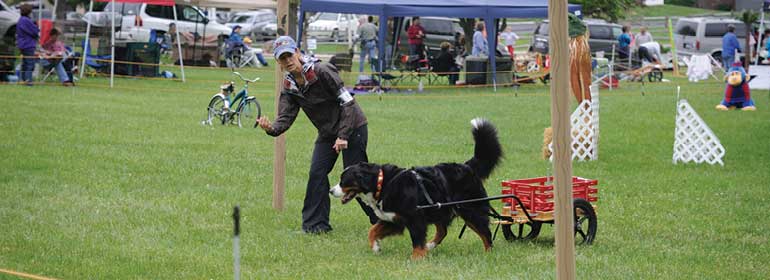Draft Test


What is a Draft Test?
Draft Test is a new discipline to Australia but it is well established in USA, Canada, The UK and Europe. Draft Tests are run by breed clubs to maintain the inherit working abilities of these draft breeds.
In Australia it is hoped that traditional drafting breeds will embrace this as the performance of these exercises is intended to demonstrate skills resulting from both instinctual abilities and training. It is a real working test!
The Draft test's purpose is to demonstrate a dog’s usefulness as a draft animal, a reliable freighting companion and worker. The test is a series of exercises designed to develop and demonstrate the natural abilities of a drafting dog in a working capacity. Many breeds have historically functioned as drafting dogs, in various capacities, and the performance of these exercises is intended to demonstrate skills resulting from both inherent ability and training, which are applicable to realistic work situations.
Dogs that pull a vehicle have to be physically strong and sound, well trained, adaptable and of good disposition. They must work well with their handler in variety of terrains and situations that they might encountered.
Efficiency in accomplishment of tasks is essential. It is also desirable that the dog works with willingness and enjoyment.
The draft team (dog and handler) are evaluated on their performance of the exercises, teamwork, willingness, ability and enthusiasm. The handler is encouraged to talk to the dog during most portions of the test. The test is judged by two judges and is non competitive; that is a pass or fail test. The Draft test is divided into three parts, one for Novice and two parts for Open.
Basic Control
On lead this is not designed to be a precise obedience performance but rather a demonstration of basic responsiveness and control, prior to hitching. A simple obedience style heeling pattern including turns, change of pace and halts must be executed, while maintaining an arm’s length between dog and handler. An off lead recall is also required in this part of the test.
Manoeuvring
In a flat ring and with an empty cart the team must negotiate a course that includes turns and circles around obstacles, successfully greeting strangers, loading and unloading the draft rig and navigating a narrow area. The dog must back a distance of thirty centimetres for Novice and one metre for Open. The dog must pass-by an audio and a visual distraction and wait while the handler moves an obstacle from their path.
Group Stay and Freight Haul
A three minute group stay is performed in the ring, while hitched to a load cart. In a Novice test the handlers remain in the ring. Open handlers go out of sight.
Following the stay the teams leave the ring for the freight haul, which traverses the natural terrain of the area, ideally including uphill and downhill slopes and changes of terrain. The team demonstrates their ability to pull and control the assigned weight (minimum of 10kg or two thirds to the dog’s body weight) over the course. The freight haul finishes back in the ring where it began. The team must pass all elements of the test to qualify.
The team need to pass all the elements of the test to qualify. Titles are awarded in Novice, Open, Novice Brace and Open Brace.
Workshops & Training Days
Workshops and training days are open to anyone who has an interest in draft work with their dog. Unsure how to start? Come along and have a look or even try it out.
Further information go to Facebook.
Draft Test Rules
The Draft Test rules are available to download here.
Draft Training Aims
- The aim is to promote good sportsmanship and a friendly training of Draft Dogs.
- To create an educational informative atmosphere so as to develop the sport.
- To promote the safe, careful, efficient training for the Draft Dogs.
The welfare of dogs is paramount at all times.
DOGS NSW heat policy apply to training (DOGS NSW Regulation Part II-Show, Section 19 Extreme Weather and Safety regulation).
Visitors are always welcome, ground rules still apply.
Draft Training Ground Rules
The ground rules listed below will apply to any person using the area and equipment set out for Draft training:
1. Bitches in season will not be allowed to train or be in the vicinity of the training area.
2. At least two members of the Draft Test Working Party must be present for training to commence.
3. Training is run by members of the Draft Test Working Party and their instructions are to be followed.
4. The attendance sheet is to be signed and training fee paid before training your dog(s).
5. Dogs are to be on lead and under control at all times in the training area.
6. Dogs are to be harnessed and hitched in the training area for work but must be unhitched at all other times.
7. Dogs must be kept quiet near the working area. Noisy dogs should be moved away from the training area.
8. Owners are responsible for cleaning up after their dog The handler of any dog that fouls the training area must clean up immediately.
9. Dogs must be minimum aged for dogs is 9 months to train.
Events
To be advised.





